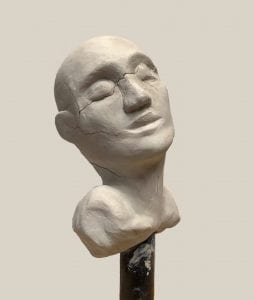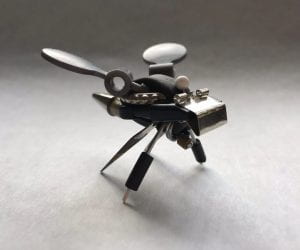The forming body of work lead to questions about control and relationships. I could evidently produce images that were personally affecting. But without resistance, nor true dialogue with an opinionated “other”, the work may merely have been self-serving and superficial. I still needed to get closer to something not rooted in display or technical concern, but more satisfyingly authentic as a conclusion.
And so I set aside the techniques I knew and picked up others that would resist manipulation to different degrees. Making art and showing art are different activities and I wanted to get more into the making of it as a place of insight instead of demonstrations for others, including for the academic environment that prompted the enterprise.
 I created three bodies of work that each resisted my control to different degrees. One included sculpture in clay, a new technique for me but easily obtained and (I thought) easily manipulated. The next was sculpture made with found materials, constructed without joiners or adhesives and so necessarily made through stubborn handling and negotiation with parts, trying to figure out how to fashion them together while also waiting and hoping to find just the right addition. The last effort was through programming and digital imagery. I had been teaching myself to work with pixels and programming, and I set about to make a program that randomly generates kind faces instantly.
I created three bodies of work that each resisted my control to different degrees. One included sculpture in clay, a new technique for me but easily obtained and (I thought) easily manipulated. The next was sculpture made with found materials, constructed without joiners or adhesives and so necessarily made through stubborn handling and negotiation with parts, trying to figure out how to fashion them together while also waiting and hoping to find just the right addition. The last effort was through programming and digital imagery. I had been teaching myself to work with pixels and programming, and I set about to make a program that randomly generates kind faces instantly.
These three efforts concluded much differently than I expected. The clay cracked and fell apart, I did not make as many pieces as I expected. The first handling of the clay was all pleasure and sensual phenomenon, but then I ended up spending longer with each piece to sustain and repair it than making it. A couple hours of sublime wet clay became weeks of stress and fracture and needy objects that could not persist independently. I felt obligated to fix them, guilty for not understanding the material; regret. It felt like being in a relationship with someone terminally ill.
 The found objectsculptures were much more feisty and resistant to handling. Occasionally made from rusty bits or sharp pieces, springs and fragments, they could only hold together through tension and friction. This meant that sometimes pieces might explode or collapse if I was not careful. When a piece was done, I needed to leave it alone and respect boundaries around further handling. Far from being needy, these objects required me to accept closure.
The found objectsculptures were much more feisty and resistant to handling. Occasionally made from rusty bits or sharp pieces, springs and fragments, they could only hold together through tension and friction. This meant that sometimes pieces might explode or collapse if I was not careful. When a piece was done, I needed to leave it alone and respect boundaries around further handling. Far from being needy, these objects required me to accept closure.
The digital images were the most easily made and experienced. The programming was challenging but not as hard as I expected and once finished, I was able to make in seconds what would take weeks of crying and inner turmoil to paint. The faces only appeared when I wanted, and faded away smoothly when I was done. And they always smiled kindly and knowingly. This was perhaps the most sophisticated body of work in terms of technique, but the conclusion was so easy that the parasocial relationship felt too meaningless to be effective.
 I ultimately felt more involved and less alone with the work that resisted and demanded more of me. This conclusion may seem obvious to some, but I needed to arrive at this myself. These are hard-won insights born of art for myself, after all. And I then realized all this time and effort put into imaginary relationships could be poured into real people and social relationships. If the most opinionated and independent “other” I could make caused the deepest feeling of connection, the natural next thing would be to look to an actual other person.
I ultimately felt more involved and less alone with the work that resisted and demanded more of me. This conclusion may seem obvious to some, but I needed to arrive at this myself. These are hard-won insights born of art for myself, after all. And I then realized all this time and effort put into imaginary relationships could be poured into real people and social relationships. If the most opinionated and independent “other” I could make caused the deepest feeling of connection, the natural next thing would be to look to an actual other person.